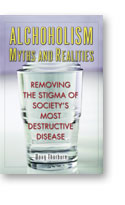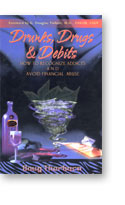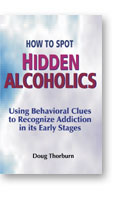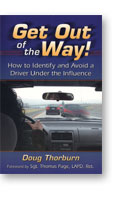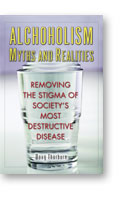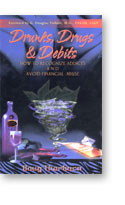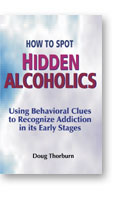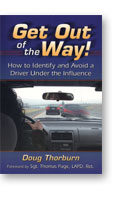 |
|
Issue #68 - January/February 2012
|
|
January - February 2012
Viewing the news through the lens of alcohol and other-drug addiction
Well over a decade ago, when I was doing research for my first book, Drunks, Drugs & Debits, I had several discussions with the gentleman I view as my greatest mentor, James Graham, about the great and horrific despots that fill the history books. I suggested, based strictly on behaviors, Adolf Hitler must have been an addict; Graham, who wrote The Secret History of Alcoholism, responded that being a child of a particularly awful alcoholic (referring to Hitler’s father, Alois) was enough to turn someone into a mass murderer. Besides, he added, Hitler was a known teetotaler. I was skeptical and thought there had to be some drug addiction that would turn a man into a monster. I kept my eyes open thinking I might find my mentor to be mistaken.
Stumbling onto a used copy of The Medical Casebook of Adolf Hitler was one of those magical moments in my quest to find examples of people in whom behaviors indicated addiction, but where no one suspected it. Its authors, the husband and wife team of Leonard L. Heston, M.D. and Renate Heston, R.N., made an incontrovertible case for amphetamine addiction in this tyrant. Further, based on admittedly scant evidence, I surmised that barbiturate addiction may have preceded the amphetamines. By the same token, finding proof of barbiturate addiction in Mao Zedong in The Private Life of Chairman Mao, by Dr. Li Zhisui, was a similar coup. Now, in this month’s “Review of the Month,” we have one of the great finds in the annals of addiction: a review of one part of a book by the great historian Paul Johnson. He unknowingly provides proof of addiction in a political philosopher whose convoluted ideas have adversely affected billions over the past 150 years: Karl Marx.
The Top Story in this issue is a bit unusual in that while we lack absolute proof of addiction, the behaviors alone provide compelling evidence. The obituaries under “Sometimes, it takes an addict” are more numerous and varied than usual, adding to the loads of evidence that alcohol and other-drug addiction leads to behavioral extremes manifesting in both creative genius and evil incarnate. Since it’s the beginning of my income-producing Season (and, wish as I might, TAR far from pays the bills), I don’t guarantee another issue of the Thorburn Addiction Report until May, even if we’ve succeeded in nearly every year to supply at least one issue somewhere in-between. However, we have tried to give you a double issue you won’t soon forget. If you enjoy reading this as much as I enjoyed researching and writing it, please forward it in its entirety to family, friends and associates and suggest they add themselves to our mailing list to receive future issues.
|
|

|
Welcome to the Thorburn Addiction Report in which we interpret the news through the lens of alcohol and other drug addiction. Each month, we bring you several sections, including: 1. Top Story of the month along with runners up, persons under watch, enablers, disenablers and more 2. Review or Public Policy Recommendation of the month 3. Dear Doug in which a recent letter to "Dear Annie" or other "help" column is rewritten, with responses given from the unique perspective that alcohol or other drug addiction best explains the misbehaviors described 4. Alcoholic Myth-of-the-Month 5. Alcoholic Antic-of-the-Month, usually where someone deserves the Darwin Award, but lived. There is something for everyone!
Addiction Report Archives here
© 2011 by Doug Thorburn
|
|
The blog is open to your comments. We’ll be interested in any thoughts you, our loyal readers, may have.
Books Here
|
|

A Con-Artist for a Mother, An Arsonist for a Son and Amphetamines May Explain it All: The Case of Dorothee and Harry Burkhart
The New Year’s headline in the Los Angeles Times read, “Arson Wave is Worst Since Riots,” referring to the 1992 riots that began when a nearly all-White jury (ten Whites, one Hispanic and one Asian) acquitted one Hispanic and three White police officers of using excessive force in the beating of a drug-addled Rodney King following a high-speed pursuit. Nearly all felonious crime is committed and instigated by alcohol or other-drug addicts. There’s no doubt about King’s polydrug addiction, and there’s little doubt that most if not all of the rioters were alcohol or other-drug addicts. The cause of this latest arson wave will likely prove to differ only in style and degree.
Both cases have aspects of the bizarre. King, who is African-American and has a history of addiction and related criminal behaviors both before and since, tried to run because he feared being sent back to prison for parole violations. He was under the influence with an estimated blood alcohol level of .19 per cent at the time of the chase. While the officers may have been too aggressive and were tried for police brutality in a criminal trial, they were acquitted, leading to the L.A. riots. The tragic result of one person’s active addiction, because he resisted arrest and may have driven police to do what codependents often do—overreact—included 53 deaths, 2,383 injuries, more than 7,000 fires and over one billion dollars in property damage.
The recent arson wave began shortly after the apprehension of Dorothee Burkhart for immigration violations and a pending extradition back to Germany, from which she had escaped while awaiting trial for a series of criminal acts. She had embezzled at least $35,000 from an unspecified number of renters and landlords, in addition to nearly $10,000 from a surgeon whom she falsely convinced would have the funds transferred into his bank account for breast augmentation. At the initial court hearing, her son Harry Burkhart unleashed an expletive-laced tirade against U.S. authorities for capturing his mother and for intending to deport her to Germany. The fires began that night and continued for several days before Harry was apprehended, after over 50 blazes were set.
The Burkhart’s didn’t start out this criminally-inclined. After fleeing to Germany in 1994 following the Russian invasion of Chechnya, Dorothee apparently worked legitimately for a time driving taxis and dealing in real estate. Only later did she turn to scamming. She also clashed often with teachers and school officials over Harry’s “learning disabilities.” Along the way, she developed paranoid conspiracy theories, becoming convinced she and her son were targeted by nearly everyone (because they were Chechnyan), especially neo-Nazis whom she believed secretly ran the country.
Police in Germany arrested her for multiple counts of fraud in 2007. After escaping and fleeing to Canada, which is now looking at Harry as a suspect in a number of unsolved arson fires, Dorothee told Canadian authorities, from whom she was requesting asylum, that she was tortured while awaiting trial in Germany. After being denied asylum in 2010 they moved to the L.A. area, where Harry got his own apartment, next door to his mother’s. At night, he placed a mattress against the door and slept on it in order to, according to reports, “keep intruders out.” A doctor diagnosed him with, among other disorders, severe anxiety and a sleep disorder, but not the obvious: paranoia.
The crimes the duo have been accused of are by themselves very strong indicators of addiction, despite the media calling Dorothee variations of “crazy” and blindly repeating Dorothee’s allegations that her son is autistic, mentally disabled and mentally ill. They both act like they’re on a panoply of drugs but, since different drugs can cause different symptoms, I wondered which one might be their drug of choice. While Dorothee’s known behaviors are suggestive, Harry’s behaviors may give away the secret: four strongly indicate amphetamine addiction. First, he committed arson, which is a particularly destructive crime; while alcoholics are perfectly capable of committing such atrocities, amphetamine addicts are probably more likely to do so. (I admit to hypothesizing here based on limited anecdotes; there are no studies of which I’m aware.) Second, the speed with which he committed the arsons is more likely consistent with pure stimulant than with other drug use. Third, he experienced apparent delusions and paranoia in believing his mother’s fears that neo-Nazis were after them. In fact, according to German authorities, Dorothee was convinced she and her son were being targeted by nearly everyone with whom they crossed paths, including neighbors and police. Heavy stimulant use, including amphetamine addiction, causes both delusions and paranoia. Fourth, Harry suffers from sleep disorder, of which amphetamine addiction is one leading cause.
The key indications of amphetamine addiction are, therefore, consistent with their known behaviors: paranoia, delusions, irritability, aggression and (for Harry at least) sleep disorders. The main contraindication is a sales clerk at a Russian pastry store Harry frequented, who said he appeared to have a hard time focusing; while amphetamine use increases concentration, this observation could be explained by the probability she saw him between uses. The key, however, may be a photo here in which his pupils—the part of the eye that reflects the light in the picture—look like they could be as big as the moon. Outside of an ophthalmologist’s office, hardly anything other than amphetamines and cocaine cause pupils to be as dilated.
While the media and public remain baffled over behaviors that are both destructive and bizarre, the best explanation isn’t “she’s crazy” or “he’s a sociopath.” The best explanation and by far the most likely is substance addiction, specifically to stimulants and, most likely, amphetamines.
|
|
Runners-up for top story of the month:
Kim Jong-un, the 28-year-old heir to the North Korean Kim dynasty following in his father’s (Kim Jong-il) footsteps as ruler of what will likely be considered the most totalitarian state ever by future historians. Kim-the-younger is depicted in U.S. intelligence assessments as a “volatile youth with a sadistic streak” and “may be even more mercurial and merciless” than his father, which is difficult to fathom. Imagine the alcoholic serial murderers Ted Bundy or Jeffrey Dahmer ruling 20 million extremely unlucky victims and you might get a picture of life under the Kim’s.
Former Illinois Governor Rod Blagojevich, sentenced to a 14-year prison term for what U.S. prosecuting attorney Patrick Fitzgerald called “the most staggering crime spree in office I have ever seen.” Among other offences he was convicted of conspiring to sell the Senate seat vacated by President-elect Obama. The litany of behaviors indicative of alcoholism were enough to qualify Blagojevich for the Top Story honor in the January 2009 edition of TAR, even though actual proof of drinking or using was not yet evident (a rare honor indeed for those in whom absolute proof is lacking). However, I think we now have all the proof possible short of an actual admission. Not only have his attorneys asked that the ex-governor be included in a prison residential drug “abuse” program, which would shave a year off his sentence; so has the judge, James Zagel, who sentenced him. While journalists reported that “no one is aware of any drug abuse problem during the three years since Blagojevich’s arrest in December 2008,” neither was “Full House” child star Jodie Sweetin’s husband, an LAPD cop, aware of her methamphetamine addiction, which was active for at least two of the five years they were married.
Under watch:
In an early 2009 piece on white collar crime, The Economist magazine mentioned something those who have read my books would predict: “Many [Club Fed and other white collar] prisoners suddenly discover, post-conviction, that they had a drinking problem….” I would add that those who don’t figure this out might benefit from greater introspection. In the spirit of The Economist’s discovery, two recent stories follow for which the evidence of alcoholism is in the crime itself.
Kinde Durkee, 58, previously charged with using funds from clients’ accounts to pay her own bills, now charged with practicing accounting without a license. The scope of the embezzlement is likely on par with some recent Ponzi schemes: she controlled more than 360 bank accounts for nearly 100 Democratic politicians, including U.S. Sen. Dianne Feinstein (D-CA), who says hundreds of thousands of dollars are missing from her campaign fund. Obviously, she wasn’t just paying “bills;” she was living high (pun intended).
Laurie Ann Martinez, 36, a licensed psychologist for the California Department of Corrections and Rehabilitation (the prison system), arrested on charges of faking a rape and robbery with the goal of persuading her husband to move to another, “safer” neighborhood. Police responding to her 911 call found her lying on the floor crying hysterically, her shirt ripped open with her breasts exposed, lip split, knuckles scraped and soaked in her own urine. With the help of a friend, Nicole April Snyder, 33, she had staged the entire scene, going so far as to have Snyder rough up her face. Incredibly, Martinez oversees a team that treats inmates with mental health issues in one of California’s state prisons. Not surprising, Martinez’s husband David is divorcing her. Less surprising, there is a vacancy for her in a state prison cell, as she moves from one side of the bars to the other.
Enabler of the month:
The U.S. government, which has been negotiating with North Korean “diplomats” hoping, as former U.N. ambassador John Bolton says, “to trade food aid for more empty promises to denuclearize.” As Melanie Kirkpatrick, senior fellow at the Hudson Institute put it, “On Pyongyang’s part, [the history of the failed denuclearization agreements] is a history marked by lies, broken promises, and clandestine programs. On the part of the U.S., the history is marked by gullibility and wishful thinking.” It’s also a history of accepting “Kim Jong-il’s promises of future good behavior in return for economic benefits.” If it’s reminiscent of parasite and host, alcoholic and codependent, it’s because it is. We addictionologists can only hope it doesn’t end as badly as it so often does when well-intentioned people attempt to “help” the addict, or believe him. Now we get Kim’s son, Kim Jong-un, who one senior U.S. official sums up in a U.S. assessment: “He has a violent streak and that’s worrisome.” When referring to alcoholics in positions of power, this official—and no doubt the U.S. government—have no idea.
Disenabler of the month:
David Martinez, who announced he is divorcing his “crazy” wife, Laurie Ann Martinez, whose issues are described in the “Under watch” section above.
Addict v. addict v. addict
Sports agent Leigh Steinberg, who represented Ben Roethlisberger among many other highly successful NFL’s pros, filing for bankruptcy protection. Steinberg, who was the inspiration for the movie “Jerry Maquire” (“Show me the money!”), admits his alcoholism caused impaired judgment resulting in his financial collapse. What he won’t say—but we will—is that he was likely taken down by other alcoholics. Taking responsibility for the debts, he avoided filing bankruptcy for years after a 2003 incident in which one of his employees, without his knowledge, took a $300,000 loan from one of his NFL clients. Aside from the fact that such loans are specifically forbidden by the NFL Players Association (NFLPA) regulations, apparently the loan went unpaid and the NFL player fired Steinberg and hired a rival agency, one run by an agent who previously “worked at” his firm and who was sued by Steinberg over the way “he left” the firm. Steinberg won the lawsuit. “There are many legal complexities,” Steinberg explained, “but in a nutshell, his representatives—the ones who lost the lawsuit—have insisted on collecting monies without informing the NFLPA that the matter is settled. The point is crucial because I did not apply for recertification by the union after one of their agents (and his wife) filed suit against me in 2006. If I cannot be recertified, I cannot work in the field that I have been trained in, which is to the benefit of this rival agent. Keeping me out of business seems to be a priority above collecting the debt, and although substantial payments have been made, the demand is now four times the original amount. My attempts to rebuild my life have been hamstrung.”
Steinberg, who seems genuinely contrite in stating “I have attempted to make amends for damage my drinking caused to others,” may be a victim of two possible alcoholics: the employee who took the loan and the rival agent, who seems unreasonable and vindictive. As I’ve often noted, both the criminal and civil justice system are filled with addicts, often on all sides.
Question of the month:
“Just how drunk were you, Francesco Schettino, Captain of the Costa Concordia? And were you a relapsing (and hidden from those that matter) alcoholic?” Several reports on the listing of the ship include clues suggesting the answers to the questions are “very” and “yes.” Clue # 1: Pier Luigi Foschi, the chairman and chief executive of Costa Cruises, reportedly said he believed that Captain Schettino “never drank alcohol.” Yet, a Dutch survivor claimed she “saw him drinking with a woman on his arm at the ship's bar.” Clue # 2: Prosecutors allege he was showing off by sailing past the Tuscan island of Giglio, where his head waiter lived, with some claiming he was piloting the cruise liner “like a Ferrari.” Clue # 3: His former captain, Mario Palombo, claimed Schettino "was too exuberant. He's a braggart. More than once I had to put him in his place."
Quote of the month:
“Jerrold M. Post, a former psychological profiler for the CIA, diagnosed Kim as having malignant narcissism, a personality disorder characterized by ‘extreme grandiosity and self-absorption….There is no capacity to empathize with others,’ [he] wrote in a study of Kim. ‘There is no constraint of conscience….Kim’s only loyalty is to himself and his own survival.’”
So wrote Barbara Demick and John M. Glionna in the Los Angeles Times story on the death of Kim Jong-il. They, along with Post (and unfortunately, perhaps, the CIA) omitted Kim’s alcoholism, which explains the “malignant narcissism,” the “extreme grandiosity and self-absorption,” the incapacity “to empathize with others,” the absence of “constraint of conscience” and the loyalty only to himself “and his own survival.” The failure to identify alcoholism at the root of all of Kim’s behaviors ensures the failure to comprehend him, and to predict we were utterly unable to predict what he might have done next. Now we get to say the same about his son, Kim Jong-un who, by the way, recently inherited some nuclear weapons.
Headline of the month:
“North Korean leader dies. Kim, 69, defied and baffled world with his nuclear aims, bizarre actions.”
So led the Los Angeles Times cover story on the death of Kim Jong-il. From a libertarian-humanist perspective, the use of the word “leader” is revolting; Kim was among the most horrific of despotic rulers. From an addictionologist’s viewpoint the idea that he “baffled” the world with “bizarre” actions would be shocking and baffling only if he was not an alcoholic. We know there is nothing baffling or bizarre about him: he did what many practicing alcoholics dream and would do if only they could be placed in identical circumstances. Kim’s alcoholism-induced behaviors are discussed in detail in the Top Story and “Review of the Month” of issue # 3 of TAR. It’s an amazing read.
Sometimes, it takes an addict:
Kim Jong-il, North Korean ruler since 1994, dead at age 69 or 70. I was a Ron Paul-style non-interventionist libertarian until I began studying alcoholism and realized there’s only one way to deal with an alcoholic sitting on nukes: take him out. (I’m with Paul on practically all domestic matters, as I believe it’s the height of arrogance to suggest I know better how to run your life and spend your money than you do—but not in this case, where his hands-off foreign policy is, I believe, naïve.) Kim is such a classic study of alcoholism and the abuse of power it’s hard to know which example of abuse to mention. However, three prime examples may help to give the unaware a “feel” for his regime. First, a night-time satellite photo shows the extraordinary contrast in lights and, therefore, civilization or its lack thereof between North and South Korea. Second, those who dare speak out against the dictator were not only dragged into the North Korean gulag (refugees frequently use the word “hell” to describe their country, which doesn’t leave words that might adequately describe its version of the gulag), but also their family members similarly “disappear.” In one (likely) extreme case, Kim’s response to the 1997 defection of a high-ranking official, Hwang Jong-yop, was to ship 3,000 of Hwang’s relatives—including many having no idea they were related to the defector—to the gulag; Kim then spent the next 13 years dispatching assassins to Seoul in a (luckily) futile attempt to murder him (Hwang died of natural causes in 2010). Third, a comparison between the standard of living of North and South Koreans shows that while their estimated living standards were similar for nearly two decades after the stalemate ending the Korean War, the South is now, monetarily, 17 times richer than the North (and these are the same sort of “official” statistics that told us the Soviets’ standard of living was roughly half of ours, when it was more like 10%). The hellhole that is North Korea is a direct result of Kim’s alcoholism-fueled egomania, for which I believe an incontrovertible case is made in the Top Story and “Review of the Month” of issue # 3 of TAR which is, again, an excellent and timely read.
Socrates Brasileiro Sampaio de Souza Vieira de Oliveira, Brazilian football (soccer) player, political agitator and intellectual, dead at 57 from septic shock caused by food poisoning, which his dining companions survived. While playing over 300 games, he talked Van Gogh and Cuban history, practiced medicine (he’d miss training sessions for his medical studies in a country where commerce stops and elections are planned around soccer) and campaigned for democracy while generals ran the country. After retiring from soccer, he blasted the corruption rampant in the game and argued his ideals at cafès through smoke and alcohol. While insisting he “never had many problems with alcohol because I was not addicted….I interacted with alcohol as if it were a partner, but I never had withdrawal symptoms. I spent long periods without use,” his liver was weakened enough from long-standing non-alcoholism that he couldn’t survive sepsis. In fact, he was hoping his health would stabilize ahead of a liver transplant.
Author Christopher Hitchens, dead at 62 from esophageal cancer. Hitchens, who wrote provocative essays on religion, politics and war also wrote an engaging series of essays about his disease, prognosis and impending death. He also acknowledged that years of heavy smoking and drinking had put him at grave risk for the often-fatal disease. Having made a case against religion in his 2007 God is Not Great: How Religion Poisons Everything, he stuck to his atheism to the end. He wrote two dozen books, including biographies of Thomas Jefferson, George Orwell and Thomas Paine. When younger he was a socialist, but began crossing the aisle in the ‘90s when, among other surprises, he lambasted President Bill Clinton as a rapist. After 9-11 he was repulsed by his perception of leftists blaming the U.S. for the attacks and supported the Bush administration’s war on terrorism, culminating in taking the oath of citizenship in 2007, on his 58th birthday, in a private ceremony at the Jefferson Memorial conducted by George W. Bush’s homeland security chief Michael Chertoff. Hitchens was described by a friend and fellow writer, Martin Amis, as “one of nature’s rebels….He has no automatic respect for anybody or anything.” And all along, he drank. I saw him in a number of television interviews in which he looked and sounded drunk and only later discovered his secret: he had outed himself years ago. He was always engaging and everyone simply accepted him for who he was. But I’m reasonably certain it would have been hell to live with him, at least some of the time.
Producer Bert Schneider, who captured the negative social mood of the late 1960s and the 1970s in “Easy Rider” and “Five Easy Pieces,” dead at age 78 of “natural causes,” no doubt exacerbated by long-standing alcoholism mentioned only in the 23rd paragraph of the Los Angeles Times obituary. Yet, the clues abounded long before that second-to-last paragraph. First, I have long hypothesized (see issue # 31 of Wealth Creation Strategies) that alcoholics are better able to capture the social mood of the times and use it to their advantage, whether as businessmen, actors, writers, musicians or other creative artists. It’s apparent from the first few paragraphs of the obituary that Schneider managed to do this in spades. Second, the headline read, “Iconoclastic producer of ‘Easy Rider’.” An iconoclast is one who attacks and seeks to overthrow long-cherished or popular ideas and institutions. Due to their insatiable need to wield power, alcoholics more often do this—and are more often successful—than are non-addicts. Third, Dennis Hopper directed and co-starred in “Easy Rider” with Peter Fonda and Jack Nicholson; addicts often hang out with other addicts (though Hopper was much more obvious in his addiction). Finally, the 23rd paragraph would give away the “secret” to the addiction aware even if it hadn’t mentioned long-standing alcoholism: “Beset by personal problems, including substance abuse and a fire that destroyed his Beverly Hills home, Schneider was estranged from his children and many of his friends in later years.” All of these indications suggest that the obituary would more accurately have read, “Bert Schneider, dead at age 78 after long-standing alcoholism compelled him to take extraordinary risks that ‘worked,’ while ruining relationships with family and friends, especially towards the end.”
Director Ken Russell, known for his flamboyant visual style in films such as “The Devils,” “Altered States,” and the Who’s rock opera “Tommy,” dead at 84 after suffering a series of strokes. He was known for irreverent BBC documentaries of prominent figures in the arts and hit the big leagues with his 1969 movie “Women in Love,” which famously included a nude wrestling scene between Oliver Reed and Alan Bates. Glenda Jackson, who won an Academy Award for best actress in the movie, said he “broke barriers” for many people. He courted controversy and was referred to as the “enfant terrible” of British cinema because of films like “The Devils,” an X-rated 1971 film about a priest and sexually repressed nuns in 17th century France (starring Vanessa Redgrave and Oliver Reed). Peter Rainer, film critic for the Christian Science Monitor said that he was different from other British directors with his “tremendous flair for flamboyance and fantasy, rich in self-indulgence and a lot of overheated imagery….[using] the lives of famous artists…as springboards for his own lurid, psychosexual fantasias.” Film critic Kevin Thomas said Russell was “a major risk taker” as a director. His heyday stretched from the late 1960s to the early 1980s, when, as Rainer pointed out, “his type of extravagance struck a chord with counterculture audiences…looking for cutting-edge experiences in the movies, both visually and sexually.” He was married four times. So what about the alcoholism, which all of the italicized words and phrases suggest (and for which I added all of the emphasis throughout)? Not a mention of it in the Los Angeles Times obituary or many others. The Guardian mentions his father, a shoe shop owner, whose “violent episodes led Russell and his mother to seek refuge in the cinema.” Only in the 14th and last paragraph was drinking even mentioned, but it’s enough: “Tributes began appearing to the director…with the comedy writer Graham Linehan recalling an anecdote from the set of "Lair of the White Worm" in which Russell’s directing style grew exponentially broader as his alcohol intake for the day increased.” The anecdote makes Russell’s alcoholism even more obvious: “The mornings would go ok, but then he would go to lunch and knock back two bottles of wine. So after lunch his acting note to everyone was simply "Bigger! BIGGER." So the performances would get bigger and sillier and more broad, until finally everyone was acting as if they were in a Carry On film. At that point he yelled "PERFECT! NOW...DOUBLE IT!"
Note to family, friends and fans of the above: the benefit of the doubt is given by assuming alcoholism (they are either idiots and fundamentally rotten, or they are alcoholic/other drug addicts—which would explain the misbehaviors). If alcoholic, there is zero chance that behaviors, in the long run, will improve without sobriety. An essential prerequisite to sobriety is the cessation of enabling, allowing pain and crises to build. Thus far, many have done everything they can to protect the addict from the requisite pain, making these news events possible. The cure for alcoholism, consequential bad behaviors and, ultimately, tragedy, is simple: stop protecting the addict from the logical consequences of misbehaviors and, where possible, proactively intervene.
|
|

|
|

Karl Marx, Alcoholic
A historian fails to diagnose the obvious
Alcoholics have had an enormous effect on human history, with both positive and negative results. As I’ve argued throughout my work (beginning with Drunks, Drugs & Debits), the effect is so immense it’s impossible to make sense of our past without understanding alcoholism. The great includes the likes of Thomas Paine, Ignaz Semmelweis and Ayn Rand. The horrific includes Jeffrey Dahmer, Ivan the Terrible, Josef Stalin and Kim Jong-il. I’ve long suspected that, if able to dig deep enough, we would find alcoholism explaining the life and thinking of Karl Marx, but until I stumbled upon historian Paul Johnson’s book, Intellectuals, I had been stymied.
The book, described by Johnson as “an examination of the moral and judgmental credentials of certain leading intellectuals to give advice to humanity on how to conduct its affairs,” includes brief vignettes of a dozen of these intellectuals. They include Jean-Jacques Rousseau (“an interesting madman” and, therefore, almost assuredly alcoholic), the poet Percy Bysshe Shelley (husband of Frankenstein’s Mary Shelley), Leo Tolstoy, Ernest Hemmingway (discussed among others in the review of the month in the October-November-December 2011 TAR), Jean-Paul Sartre, Lillian Hellman and Karl Marx. That we have positively identified at least five of the twelve intellectuals as alcoholics —who this great historian believes have made their mark—demonstrates the staggering effect alcoholism has had on history.
The 30 pages devoted to Marx are a fascinating chronicle of a previously undiagnosed alcoholic’s life. It’s especially powerful given that, as Johnson says, “Marx has had more impact on actual events, as well as on the minds of men and women, than any other intellectual in modern times.” Moreover, his influence created more pain and suffering than anyone else—ever—by giving totalitarian despots, including Stalin and Mao, a pretext for murdering tens of millions.
Marx’s most important theme and foundation for the mass of his ideas was that the more capital employed, the greater the exploitation of workers. In Johnson's words: “capitalism produces ever-worsening conditions; the more capital employed, the more badly the workers had to be treated to secure adequate returns.” This is the opposite of the truth (and entirely at odds with the views explicated in “The Wealth of Individuals: Part 2” in issue # 34 of Wealth Creation Strategies). Twisted logic is a key behavioral clue to alcoholism in an intellectual, and this is about as twisted as it gets. So is intellectual dishonesty—he justified this absurdity by citing one work published twenty years earlier (Engels’) which, in turn, was “based not on primary sources but on a few secondary sources of dubious value” and which was itself as much as forty years out of date, even though Marx cited it as contemporary. His evidence included “small, inefficient, undercapitalized firms in archaic industries which in most cases were pre-capitalist….[where] conditions were bad precisely because the firm had not been able to afford to introduce machinery, since it lacked capital….[Marx ignored] the truth which stared him in the face: the more capital, the less suffering.”
Another extraordinary instance of intellectual dishonesty involved the deliberate falsification of a sentence from W. E. Gladstone’s Budget speech of 1863. Gladstone said, “I should look almost with apprehension and with pain upon this intoxicating augmentation of wealth and power if it were my belief that it was confined to the class who are in easy circumstances; [however,] the average condition of the British laborer…has improved during the last twenty years in a degree which we know to be extraordinary, and which we may almost pronounce to be unexampled in the history of any country and of any age.” However, Marx claimed Gladstone said, “This intoxicating augmentation of wealth and power is entirely confined to [the propertied class].” As Johnson points out, “it would be hard to conceive of a more outrageous reversal of his meaning,” and almost unimaginable that after his misquote was pointed out, he nevertheless reproduced it in his book Das Capital. Later, “when the falsification was again noticed and denounced, he let out a huge discharge of obfuscating ink,” a debate he (and later his codependent heirs) carried on for at least two decades. As readers of my books know, alcoholics can be great and persistent liars.
Johnson asks, if a love of truth didn’t motivate Marx, what did? Johnson believes four aspects of character “deeply rooted in the personality” supplied his “energizing” force: “his taste for violence, his appetite for power, his inability to handle money and, above all, his tendency to exploit those around him.” All of these character flaws are manifestations of alcoholism; if true, they lie at the root of all of his thinking and behaviors.
Marx exhibited fury, especially when his views couldn’t be supported by facts. He was extraordinarily hostile to his fellow revolutionaries, particularly when they experienced real life, something Marx wasn’t interested in—“he never set foot in a mill, factory, mine or other industrial workplace in the whole of his life.” In fact, Marx looked only for facts that fit his preconceptions and, when the facts didn’t support his ideas, falsified, misrepresented and deceived.
Marx used violent expressions throughout his writing and speech and, in real life, engaged in “huge bursts of rage.” While a journalist, he held “editorial meetings…behind closed windows so that people outside could not hear the endless shouting.” He quarreled with everyone “unless he succeeded in dominating them completely” and spent much time, in anticipating Stalin, by “collecting elaborate dossiers about his political rivals and enemies.” He often used the phrase, “I will annihilate you” which, along with his actions, suggests to Johnson he “would have been capable of great violence and cruelty” had he ever gained a true position of power. Because he was never in such a position, “his pent-up rage therefore passed into his books.” Each of these behaviors is consistent with a diagnosis of alcoholism.
In fact, almost every description by Johnson of Marx’s thinking and behavior is indicative of this brain disease, which becomes nearly incontrovertible when there are dozens of examples. Johnson describes Marx as having a “withering contempt for all non-scholars” and hatred of “usury and moneylenders.” Marx endorsed and quoted anti-Semitic views with approval, asking “What is the worldly cult of the Jew? Huckstering. What is his worldly god? Money.” Johnson argues Marx’s philosophy was created around his desire to “make the Jew impossible” by abolishing “the preconditions, the very possibility of the kind of money activities which produced him.” Capricious hatred of others, including classes of people, is common among alcoholics. It allows them to wield power by keeping others off balance and serves to deflect blame.
What might have triggered such hatred in a brain-damaged individual? Marx was often driven “into the hands of moneylenders at high rates of interest,” which Johnson surmises could explain “why his entire theory of class is rooted in anti-Semitism, and why he included in Capital a long and violent passage denouncing usury….” His money problems “began at university and lasted his entire life.” His attitude about money was, in fact, “childish”: he “borrowed money heedlessly, spent it, then was invariably astounded and angry when the heavily discounted bills [!!!], plus interest, became due.” He “adopted a pattern of living off loans from friends and gouging periodic sums from the family.” He inherited what were then sizeable amounts from both parents and various other relatives; at no point did his income fall below “three times the average wage of a skilled workman” and yet he was “always in debt, often seriously….” Alcoholics often spend more than they earn their entire lives.
The sick mind usually extends hatred from groups to individuals. He ended up in a “total breach with his mother” and suddenly cut off other friends, especially after they questioned him; when a devoted colleague suggested “he would find no difficulty in finishing Capital if only he would organize his life a little better, Marx broke with him for good and subjected him to relentless abuse.” He exploited his wife, whose jewelry and silver he pawned, as well as his three daughters, since although he could have afforded the expense (and the girls were clearly “clever”) “he denied them a satisfactory education, refused to allow them to get any training, and vetoed careers absolutely.” And although he feigned defending the “working class,” he never paid his cook and maid Helen Demuth (known as “Lenchen”) from the time she came to work for him in 1845 (she worked for the family for 45 years). Further, Lenchen became Marx’s mistress and conceived a child, whom Marx “refused to acknowledge [as] his responsibility, then or ever,” terrified that if his son’s paternity was discovered he would suffer irreparable damage as “revolutionary leader and seer.”
All of these read like a catalogue of behaviors indicative of the alcoholic need to wield mercurial power over others. Contempt, hatred and blaming others are all, as described in How to Spot Hidden Alcoholics, typical ways by which the alcoholic inflates his ego at the expense of others. Violent rages, hostility and lies—especially twisted logic and intellectual dishonesty—are hallmarks of the disease. The purposeful misquote of Gladstone is similar in vileness to the false accusations that I have suggested elsewhere are rarely if ever made by non-alcoholics. The four “energizing” forces Johnson avers are all consistent with alcoholism—the alcoholic must wield power over others in a bid to inflate the ego and often displays poor judgment in financial affairs, having a need to spend money even while bankrupting himself and often those around him. This is frequently accomplished by exploiting well-intentioned (but naïve) family and friends. Unreasonable resentments and the instantaneous cutting off of long-cherished relationships are also classic alcoholism-fueled behaviors, as is acting like a child.
Utilizing Appendix 1 in How to Spot Hidden Alcoholics, 25 of 35 early-stage non-use-related behavioral indications of alcoholism are satisfied: behavioral clues 1, 3, 4, 5, 7, 8, 10-17, 19-22 and, 25-30 can all be answered in the affirmative, while several others could not be answered in the 19th century, since telephones and automobiles weren’t invented. However, without confirmation of heavy drinking we cannot be absolutely certain of a diagnosis of alcoholism.
Despite this evidence, Johnson displays a typical ignorance of alcoholism when he flatly states, “Marx was not an alcoholic.” He finishes this sentence by adding, “But he drank regularly, often heavily and sometimes engaged in serious drinking bouts.” Three pages later, he continues: Marx “smoked heavily, drank a lot, especially strong ale, and as a result had constant trouble with his liver.” In addition, Johnson describes Marx's suffering of boils for a quarter century, including carbuncles, boils that merge to form a single deep abscess with several heads. According to diagnose-me.com, both boils and carbuncles “are more likely to develop in those with…alcoholism or drug abuse.” Finally, putting the nail in the coffin Johnson cites a “clever Prussian police spy describing in great detail the activities of the German revolutionaries centered around Marx,” including the fact that Marx was “often drunk.” Even though Johnson presents clear, undeniable evidence of alcoholism to his readers, he fails to explicitly recognize and diagnose the disease in his subject. Had he understood alcoholism, he would might written, “Marx exhibited thinking and behavior patterns consistent with early-to-middle stage alcoholism. He also drank heavily. He was, therefore, an alcoholic—and, perhaps, the most destructive in history.”
I often say, alcoholism explains “only” 80% of society’s ills, woes and dysfunctions. However, now that we’ve confirmed alcoholism in the man who is alone responsible for perhaps 80% of the horrifying tragedies that fill books of recent history, we might up this to 90%.
Click here to check out Doug's movie reviews.
|
 Homeowner association board from hell Homeowner association board from hell
Dear Doug:
A couple of board directors who are alcoholics have entered into contracts, negotiated with vendors and made decisions regarding maintenance projects while inebriated. They have not recalled signing contracts or conversations and promises made to owners, vendors and management. Other board members have learned about contracts too late to rescind them, but are loathe to confront them because the last time they did so things turned ugly. The irony is the alcoholic members keep getting re-elected because they are generally well-liked, even though everyone knows we’ve been bound by contracts we never should have entered into. How do we tactfully handle this and not get sued for discrimination?
Signed,
The “other” board members
Dear Codependents,
Other columnists would point out any tactful method for handling this flew out the window when the alcoholics suffered memory loss. They’d tell you that signing contracts and not remembering doing so is reckless, which violates the requirement that they take their obligations seriously and refrain from such behavior. They would suggest various legal ways of removing these board members and making them liable for any damages resulting from their breaches of duty.
Such columnists would not explain that these members repeatedly get re-elected because of all-too-common alcoholic charm and that this can turn to vitriolic hatred and vengeance on a dime once they see their positions of power threatened or taken away. Because their lies are far more believable than your truths and they may seek revenge (you don’t know what “ugly” is, yet), the other members should immediately hire an attorney to guide the association in ridding themselves of these dangerous parasites. In addition, for everyone else’s safety, an off-duty policeman should be hired supervise any meetings these directors attend, especially those that seek to remove them. Finally, if these board members live among you, great care should be taken to avoid run-ins with people whose behaviors you really can’t predict.
(Source for story idea: “Associations,” a column written by Stephen Glassman and Donie Vanitzian, The Los Angeles Times, November 13, 2011.)
|
|

“False reports of sexual assault are extremely rare… [According to the U.S. Department of Justice] only 2.5 percent of reports turn out to be false.”
So claimed Beth Hassett, executive director of Women Escaping a Violent Environment, in commenting on Laurie Ann Martinez’s arrest for staging a rape, reported in the “under watch” section above. With due respect to women who have been sexually assaulted, of which possibly 75% go unreported (some sources claim 95%), false accusations are one of the most effective means by which addicts wield power. This is especially true of those who cannot easily physically overpower others, including women.
I have written at least twice about such accusations. The Top Story in the first issue of TAR involved a likely false accusation of rape concerning NBA star Kobe Bryant. The Top Story in issue # 20 discussed what turned out to be a false accusation of rape of then 27-year-old stripper Crystal Gayle Mangum by several members of the Duke University lacrosse team. (In a classic case of prosecutorial misconduct for which he was later disbarred, District Attorney Mike Nifong was not only complicit in the false accusations, but also hid evidence that would have quickly exonerated the players.)
Hard statistics are exceedingly difficult to come by. Often, addict is pitted against addict, which can make it impossible for anyone other than those directly involved to ever ascertain the truth. That said I suspected at least a quarter of such accusations are false when I found an article written by libertarian feminist Wendy McElroy supporting my estimate.
In a piece entitled “False Rape Accusations May Be More Common Than Thought” published by the Independent Institute in May 2006, McElroy argues that false accusations of rape are common. She points out that the crime of “bearing false witness,” i.e. making a false accusation, is rarely tracked or punished. While “politically correct feminists” make unsubstantiated claims that such false accusations comprise only 2 percent of all reports, men’s rights websites point to research suggesting a rate as high as 41 percent. Arguing for the idea that the truth is somewhere in the middle (but 10 times the figure Hassett claims), McElroy quotes a 1996 FBI study reporting that “out of roughly 10,000 sexual assault cases since 1989, about 2,000 tests have been inconclusive, about 2,000 tests have excluded the primary suspect, and about 6,000 have ‘matched’ or included the primary suspect.” She adds that the authors reporting the FBI study, Peter Neufeld and Barry C. Scheck, co-founders of the Innocence Project (which seeks to exonerate those falsely imprisoned for allegedly committing all manner of felonious crimes), pointed out the percentages remained constant over the seven years ending in 1996 and “the National Institute of Justice’s informal survey of private laboratories reveals a strikingly similar 26 percent exclusion rate.”
Then where does the 2 percent figure come from? McElroy found it in Susan Brownmiller’s 1975 book on sexual assault, Against Our Will and elsewhere, but never with a citation or “with only a vague attribution to ‘FBI’ sources.” To the contrary, she quotes a leading scholar on rape law, Professor of Law Michelle Anderson of Villanova University Law School (now Dean of City University of New York): “No study has ever been published which sets forth an evidentiary basis for the two percent false rape complaint thesis.”
McElroy cites a few small studies, one from an unnamed small Midwestern city and two from major universities, concluding that 45-50 percent of rape accusations were false. McElroy concludes that while the 50 percent figure seems high, “False accusations are not rare. They are common.” Any addictionologist, who grasps the fundamental idea of alcoholic egomania and the consequential need to wield capricious power over others, would agree. Beth Hassett and other “politically correct” feminists, please take note.
|
|

Story from “This is True” by Randy Cassingham, with his “tagline:”
“GIVE ME AN A! After a student informed the principal at Charlotte High School in Punta Gorda, Fla., math teacher Jeff Spires was confronted and admitted it: yes, he sold better grades to the kids for cash payments of $40-70. The students would staple or paper-clip the cash to quizzes, and Spires, 36, would increase their grades. Why? ‘Maybe I see the kids as desperate as I am,’ Spires allegedly told a school district investigator, who said Spires ‘went on to say that he was in financial straits due to bankruptcy, arrests, and jail time.’ Charlotte County Jail records show Spires has been jailed three times in the past two years, for charges including DUI, driving with a suspended license, and probation violation. Spires has resigned from the school. (RC/Sarasota Herald-Tribune, WINK-TV) ...Teacher bribery isn't the scandal here. School teachers keeping their jobs when they are ‘in financial straits due to bankruptcy, arrests, and jail time’ is the scandal.”
Not to mention alcoholism. In fact, the tragedy is Spires wasn’t given the choice of loss of his job or abstinence early on. With the proper incentives and enforcement, addicts often make the right choice, which frequently leads to sobriety. As soon as misbehaviors are spotted—and there are always misbehaviors of some sort—alcoholism should be suspected. When the likelihood involves someone dealing closely with children, the law could easily (and justifiably) require abstinence. If the law had done what it should do—intervene early—the tragedy of bribing children and the trail of arrests, imprisonment and bankruptcy would likely not have occurred.
(Story and tagline from “This is True,” copyright 2012 by Randy Cassingham, used with permission. If you haven't already subscribed to his newsletter—the free one at least, or the paid one I get, with more than twice the stories—I highly recommend it: www.ThisIsTrue.com.)
|
Comments
To view reader's comments on last month's Thorburn Addiction Report and Doug's responses please visit the Thorburn Weblog at PrevenTragedy.com.
Thorburn Blog
|
Doug's new book, Alcoholism Myths and Realities, is now available at
GaltPublishing.com, Amazon.com and bookstores near you.
"Every policymaker in America needs to read your book exposing the myths of chemical addiction...Excellent book."
— Jim Ramstad, Member of U.S. Congress (MN)
"My father died of alcoholism. His father died of alcoholism. Three generations of alcoholism is enough. Now is the time to abandon superstition and pseudoscience, to debunk the myths surrounding alcoholism, and to apply science to solving this problem. Doug Thorburn's book is a model example of how this should be done. Read it and be prepared to change your thinking on this important topic. When enough of us understand what is really going on with alcoholism, society can make the shift from treatment to prevention and intervention."
— Michael Shermer, publisher, Skeptic Magazine and columnist, Scientific American
Buy your copy of Alcoholism Myths and Realities for only $14.95 or get the whole collection PLUS a two-hour audio cassette from Galt Publishing for just $49.95 plus tax and shipping. That's a $72.75 value for only $49.95.
To order online, click the following link (be sure to put "TAR SPECIAL" in the comments section of the order form.) Orders can also be placed by phone: 800-482-9424 OR fax: 818-363-3111.
If you wish to pay by check, send the appropriate payment with your shipping information and the words "TAR SPECIAL" in the "memo" section of your check to: PO Box 7777, Northridge, CA 91327.
Click here to purchase any of the above Thorburn books
|

Have you visited the Prevent Tragedy Foundation" The Prevent Tragedy Foundation is a tax-exempt 501c-3 organization, the goal of which is to educate the general public on the need for early detection of alcohol and other drug addiction. The Foundation is intended to answer a question that has been all-but-ignored by similar organizations: what does alcoholism look like before it becomes obvious"
Click here to visit the Prevent Tragedy Foundation |
|
Subscriptions
The Thorburn Addiction Report is a free newsletter published by Galt Publishing and PrevenTragedy.com. Subscibe by visiting our web site at www.PrevenTragedy.com.
|
The Thorburn Addiction Report is available to newspapers as a regular feature column.
Inquiries are invited.
Copyright Doug Thorburn All Rights Reserved.
ALL broadcast, publication, retransmission to e-mail lists, WWW or any other copying or storage, in any medium, online or not, is strictly prohibited without prior written permission from the author. Manual forwarding by e-mail to friends is allowed if 1) the newsletter is forwarded in its entirety and 2) no fee is charged. Please forward no more than three issues to any one person -- after that, they should get their own free subscription. We appreciate people who report violations of our copyright to us.
TO COMMENT to the author,
send your email to report@preventragedy.com or write to
Doug Thorburn, P.O. Box 7777, Northridge, CA 91327-7777
|
 |




